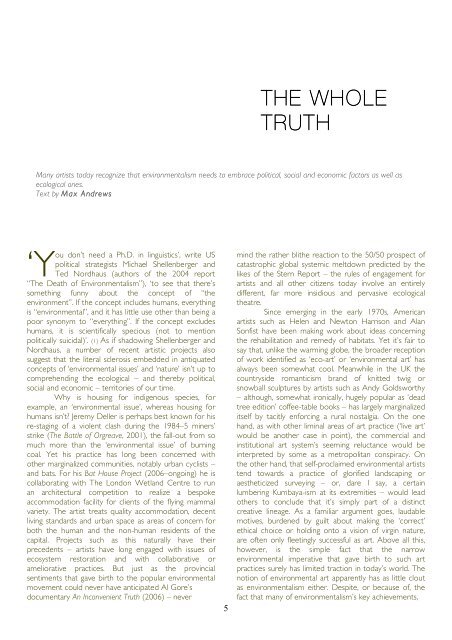M - Antennae The Journal of Nature in Visual Culture
M - Antennae The Journal of Nature in Visual Culture
M - Antennae The Journal of Nature in Visual Culture
Create successful ePaper yourself
Turn your PDF publications into a flip-book with our unique Google optimized e-Paper software.
‘Y<br />
ou don’t need a Ph.D. <strong>in</strong> l<strong>in</strong>guistics’, write US<br />
political strategists Michael Shellenberger and<br />
Ted Nordhaus (authors <strong>of</strong> the 2004 report<br />
“<strong>The</strong> Death <strong>of</strong> Environmentalism”), ‘to see that there’s<br />
someth<strong>in</strong>g funny about the concept <strong>of</strong> “the<br />
environment”. If the concept <strong>in</strong>cludes humans, everyth<strong>in</strong>g<br />
is “environmental”, and it has little use other than be<strong>in</strong>g a<br />
poor synonym to “everyth<strong>in</strong>g”. If the concept excludes<br />
humans, it is scientifically specious (not to mention<br />
politically suicidal)’. (1) As if shadow<strong>in</strong>g Shellenberger and<br />
Nordhaus, a number <strong>of</strong> recent artistic projects also<br />
suggest that the literal sclerosis embedded <strong>in</strong> antiquated<br />
concepts <strong>of</strong> ‘environmental issues’ and ‘nature’ isn’t up to<br />
comprehend<strong>in</strong>g the ecological – and thereby political,<br />
social and economic – territories <strong>of</strong> our time.<br />
Why is hous<strong>in</strong>g for <strong>in</strong>digenous species, for<br />
example, an ‘environmental issue’, whereas hous<strong>in</strong>g for<br />
humans isn’t? Jeremy Deller is perhaps best known for his<br />
re-stag<strong>in</strong>g <strong>of</strong> a violent clash dur<strong>in</strong>g the 1984–5 m<strong>in</strong>ers’<br />
strike (<strong>The</strong> Battle <strong>of</strong> Orgreave, 2001), the fall-out from so<br />
much more than the ‘environmental issue’ <strong>of</strong> burn<strong>in</strong>g<br />
coal. Yet his practice has long been concerned with<br />
other marg<strong>in</strong>alized communities, notably urban cyclists –<br />
and bats. For his Bat House Project (2006–ongo<strong>in</strong>g) he is<br />
collaborat<strong>in</strong>g with <strong>The</strong> London Wetland Centre to run<br />
an architectural competition to realize a bespoke<br />
accommodation facility for clients <strong>of</strong> the fly<strong>in</strong>g mammal<br />
variety. <strong>The</strong> artist treats quality accommodation, decent<br />
liv<strong>in</strong>g standards and urban space as areas <strong>of</strong> concern for<br />
both the human and the non-human residents <strong>of</strong> the<br />
capital. Projects such as this naturally have their<br />
precedents – artists have long engaged with issues <strong>of</strong><br />
ecosystem restoration and with collaborative or<br />
ameliorative practices. But just as the prov<strong>in</strong>cial<br />
sentiments that gave birth to the popular environmental<br />
movement could never have anticipated Al Gore’s<br />
documentary An Inconvenient Truth (2006) – never<br />
5<br />
THE WHOLE<br />
TRUTH<br />
Many artists today recognize that environmentalism needs to embrace political, social and economic factors as well as<br />
ecological ones.<br />
Text by Max Andrews<br />
m<strong>in</strong>d the rather blithe reaction to the 50/50 prospect <strong>of</strong><br />
catastrophic global systemic meltdown predicted by the<br />
likes <strong>of</strong> the Stern Report – the rules <strong>of</strong> engagement for<br />
artists and all other citizens today <strong>in</strong>volve an entirely<br />
different, far more <strong>in</strong>sidious and pervasive ecological<br />
theatre.<br />
S<strong>in</strong>ce emerg<strong>in</strong>g <strong>in</strong> the early 1970s, American<br />
artists such as Helen and Newton Harrison and Alan<br />
Sonfist have been mak<strong>in</strong>g work about ideas concern<strong>in</strong>g<br />
the rehabilitation and remedy <strong>of</strong> habitats. Yet it’s fair to<br />
say that, unlike the warm<strong>in</strong>g globe, the broader reception<br />
<strong>of</strong> work identified as ‘eco-art’ or ‘environmental art’ has<br />
always been somewhat cool. Meanwhile <strong>in</strong> the UK the<br />
countryside romanticism brand <strong>of</strong> knitted twig or<br />
snowball sculptures by artists such as Andy Goldsworthy<br />
– although, somewhat ironically, hugely popular as ‘dead<br />
tree edition’ c<strong>of</strong>fee-table books – has largely marg<strong>in</strong>alized<br />
itself by tacitly enforc<strong>in</strong>g a rural nostalgia. On the one<br />
hand, as with other lim<strong>in</strong>al areas <strong>of</strong> art practice (‘live art’<br />
would be another case <strong>in</strong> po<strong>in</strong>t), the commercial and<br />
<strong>in</strong>stitutional art system’s seem<strong>in</strong>g reluctance would be<br />
<strong>in</strong>terpreted by some as a metropolitan conspiracy. On<br />
the other hand, that self-proclaimed environmental artists<br />
tend towards a practice <strong>of</strong> glorified landscap<strong>in</strong>g or<br />
aestheticized survey<strong>in</strong>g – or, dare I say, a certa<strong>in</strong><br />
lumber<strong>in</strong>g Kumbaya-ism at its extremities – would lead<br />
others to conclude that it’s simply part <strong>of</strong> a dist<strong>in</strong>ct<br />
creative l<strong>in</strong>eage. As a familiar argument goes, laudable<br />
motives, burdened by guilt about mak<strong>in</strong>g the ‘correct’<br />
ethical choice or hold<strong>in</strong>g onto a vision <strong>of</strong> virg<strong>in</strong> nature,<br />
are <strong>of</strong>ten only fleet<strong>in</strong>gly successful as art. Above all this,<br />
however, is the simple fact that the narrow<br />
environmental imperative that gave birth to such art<br />
practices surely has limited traction <strong>in</strong> today’s world. <strong>The</strong><br />
notion <strong>of</strong> environmental art apparently has as little clout<br />
as environmentalism either. Despite, or because <strong>of</strong>, the<br />
fact that many <strong>of</strong> environmentalism’s key achievements,












